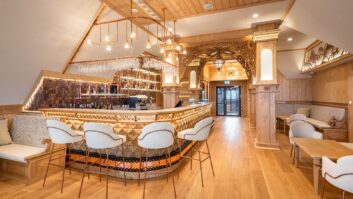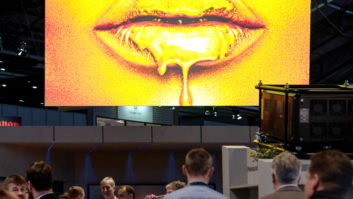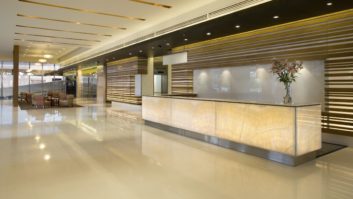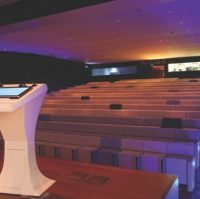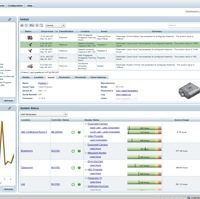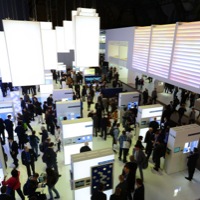
Visitor attendance at this year’s Light+Building reached a total of 196,000, marking a 7% increase on the previous event held at the Messe Frankfurt in 2010. On the show floor 2,352 manufacturers from 50 countries presented their latest products and trends for the fields of lighting, electrical engineering, home and building automation and software for the construction industry, representing a 9% increase on exhibitors from the show’s previous offering.
“Light+Building is the world’s biggest trade fair for energy efficiency. Accounting for 40% of the total, buildings are the world’s biggest consumer of energy and, therefore, play an important role for smart grids and decentralised energy supply. The very good result shows the extent of worldwide demand for environmentally friendly light and building services solutions – and that Light+Building is the foremost meeting place for the industry and decision makers,” commented Wolfgang Marzin, president and CEO of Messe Frankfurt. LED transition The lighting industry has long been aware of the benefits of LED light sources; on average a white LED lamp can last around 100,000 hours, with 11 years of full operation and 22 years of 50% operation. Moreover these sources are free of toxic chemicals, whereas most conventional florescent light bulbs contain materials such as mercury.
But despite LEDs ticking all the boxes where energy efficiency and eco-friendship are concerned, price and standardisation have both been left stationary while the technology has thundered ahead.
“With LED light sources everywhere it’s about finding the right way to control them,” commented Guy Simmonds, national sales manager at Lutron.
Cooper Controls’ European sales manager Lucien McQueen supported this statement and developed the ideas further: “Standardising LEDs is one of the big issues because they’re hard to regulate. There are many different types of drivers and this can pose long-term problems for any project.”
Manufacturers and distributors at the show were in agreement that LED technology has been developing with no uniform guidance. It is widely recognised that if a building undergoes installation of an LED lighting system, then the installers are tied down to a particular manufacturer because its LED light engines work together with light sources almost exclusively. This leaves little or no freedom should the building require new lighting fixtures or a change to the system. Unlike the CFL segment of the lighting industry, there has been no precedent for LED light engines.
However, change is on the horizon; with organisations such as Zhaga – an international consortium aiming to create standardisation in LED lighting – making its way into the industry, companies are welcoming the potential for complete interoperability between LED light sources.
“The market is currently in a transitional period from CFL to LED. We’re beginning to build our reputation in the LED market as we feel this is the right place to be,” stated Fred Bass, director at Neonlite, the company behind the Megaman lighting brand, which is a member of the Zhaga initiative. “But customers are often confused by the LED industry because there is so much out there and no standardisation.”
McQueen reiterated: “There’s definitely a big future for LED lighting but at the minute it’s not quite there in terms of cost-benefit for large-scale commercial lighting applications such as offices blocks. At the moment CFL is much more cost effective because larger areas can be lit for half the cost, and it may take a few years for LEDs to reach that cost point.”
Bass confirmed: “Yes the majority of the business is in CFL at the moment, but the market is moving so fast that it won’t be long before LED light sources take the lead. They’re plenty powerful enough, and you get more flexible lighting options from them. For instance you can’t get an 8º beam from a CFL.”The Z factor Since forming in February 2010, Zhaga has grown to consist of over 180 members from Asia, Europe and North America. The consortium’s goal is to enable easy integration of LED technology through the interchangeability of LED light sources made by different manufacturers.
“All the successful light sources have always been interchangeable. This allows luminaire manufacturers to choose from many manufacturers, providing countless lighting options,” stated Zhaga’s secretary general Menno Treffers.
To put Zhaga’s two years of gathered momentum into perspective, the organisation was not even present at the previous Light+Building show in 2010, but had its logo featured by no fewer than 30 companies at this year’s edition.
Zhaga represents the change the industry is adapting to in response to the outdated single-track system that was previously in place. Under the old system, if an LED installer used devices from a particular manufacturer, then the building was chained to that manufacturer until the entire system was replaced.
“With Zhaga now organising everything, a spin-off to this is that the whole industry gets together every month or two and this really contributes to the forward movement of the industry. The practical discussions that take place in these meetings contribute to the writing of the theorised book,” stated Bass.
Currently there are six books that detail Zhaga standards by which member companies abide. The open-membership association is currently working on book seven, entitled ‘Office LED light engine with separate electric control gear’, as the consortium moves quickly to compile new specifications. Building managementWith energy efficiency the central theme to this year’s Light+Building, exhibitors were keen to show how they’re approaching the subject of complete lighting solutions for buildings.
Lutron, which is currently involved in RE:FIT London – a scheme aimed at making London’s public buildings more energy efficient – showcased Quantum, a light management system that aims to reduce commercial lighting energy output by up to 60%. The system consists of a range of products form the Lutron energy suite that allow users to configure, control and monitor all electric light and daylight within a building to save money and energy.
“We’re experiencing a rise in the retrofitting segment of the market, especially in Europe because of the economic downturn. Companies aren’t investing in new builds anymore, and instead they’re updating existing systems in existing buildings to make them more efficient,” commented Simmonds.
Helvar presented a new building management system for lighting applications. Created from a partnership with software manufacturer Tridium, the Helvar Tridium Driver features the software company’s Niagara AX Workbench, which is connected to either a Tridium controller or AX supervisor. The system works as an operating tool for users of Helvar’s Digidim and Imagine systems.
Integrators can customise the user interface to create a graphical front page and a number of pages beyond to analyse building operation. The software collates data and presents live representations for the facilities manager to assess; energy usage is logged, automated reports are gathered, alarms activate if a light fails or any of the system’s components is abnormal, and a traffic light system represents overall system condition. This system also takes into account HVAC systems.
According to Paul Wilmshurst, Helvar’s UK managing director, the company is moving to the bigger solution to cater for systems on a commercial scale and it is using the new Tridium controller as its launchpad. “Traditionally, Helvar has worked on smaller-scale projects. But we’ve recognised the cost-benefits of moving more into the commercial side of the industry, which takes the same amount of work. We think Tridium can help us make the transition.”
Cooper Controls exhibited three of its lighting management solutions: the iLight for intelligent lighting control over residential, commercial and restaurant applications; Greengate, an energy management lighting control for industrial applications; and iLumin for visually impacting solutions in retail, commercial and hospitality. Show floorAnolis – the architectural division of Robe – demonstrated its ArcSource outdoor range of LEDs at the show.John Saunders, sales director at Anolis, commented: “We’re currently experiencing growth in Russian-speaking territories and their respective markets. On top of this the UK is also proving to be a good market for us in 2012 – both have exceeded our expectations for the year.”
“In the past, designers and architects have lost face for not selecting the right product for applications, and have been caught out by the cheap LED products that are out there. Customers are coming to us because they know we supply quality LED products, and they’re now prepared to make that investment.”
Megaman debuted its TECOH OEM LED, with light from the module reflected by an 8m in diameter dome, which was suspended over the company’s exhibition stand. The TECOH LED comprises two ranges: the MHx and CFx, both of which have been developed as an alternative to halide and compact fluorescent lamps. The MHx range uses a double axial mounted LED array and a unique patented thermally conductive base and head design, while the CFx range has an integrated driver for general lighting and is designed in line with proposed Zhaga specifications.
Pulsar presented a number of products at the show. Its ChromaZone LED fixture control unit, launched in January, provides control for Pulsar’s ChromaRange of LED fixtures. The unit is contained in a compact chassis and features DMX input with 6-, 9-, 32-, 42- and 46-channel modes, two independent chases each with 31 built-in effects, and remote access from the DMX output.
Selux and ART+COM, a designer of innovative media solutions, showcased their Manta Rhei, a 1.2m x 2.4m OLED light. The structure has integrated technology to produce mechanical movement, and features 140 paper-thin OLED modules. Different intelligent control settings create a variety of motions, and one such chorography – the gentle movement of a Manta ray – is where the name is derived.
More from the show floor came from Acclaim Lighting, which presented its Catwalk Panel RGB, a touch-sensitive LED video panel housed in a polycarbonate casing. New from the company is its DynaGraze Interior and Exterior single LED models, which feature smooth linear dimming with ELV modules.
Elsewhere, Barthelme LED solutions collaborated with Art Aqua and Alphamesh to create a dynamic waterfall feature illuminated by a Bergamo luminaire wall washer (1W power LED).
Sommer Cable presented its Syswall 45,50,55 models – which debuted at Prolight + Sound – at Light+Building. Modules for different cable connections slot into the system, which is then mounted to the wall, making it customisable for specific applications.
“With more technology going into the classroom there is more need for safe cabling systems that adhere to European standards. It’s no longer just about the product that is being installed, like a whiteboard or projector, it’s about the complete system and we’re able to provide solutions which contribute to a safe system,” said Peter Rieck, key account and distribution manager at Sommer Cable.
The next Light+Building will be held in Frankfurt from 30 March to 4 April 2014. www.anolis.euwww.megamanuk.comwww.sommercable.com www.barthelme.de www.acclaimlighting.comwww.selux.com www.lutron.com/europewww.pulsarlight.comwww.robe.czwww.coopercontrol.comwww.helvar.comwww.zhagastandard.org
